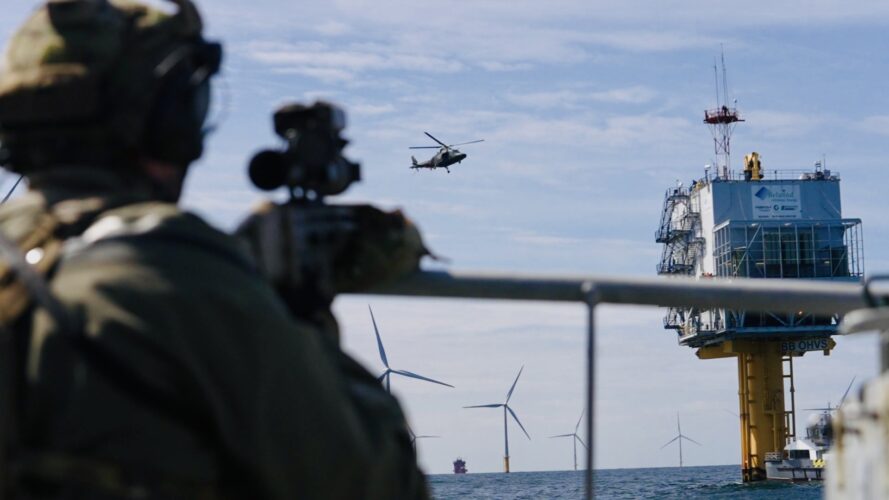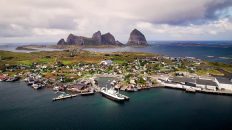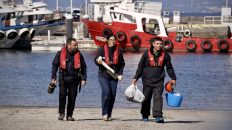Belgian authorities are stepping up efforts to ensure the safety of offshore infrastructure in the North Sea following a series of incidents that raised fears of attacks on underwater internet cables, gas pipelines and wind farms.
Sightings of an undetected Russian ship in both Dutch and Belgian waters last November prompted intelligence officials to question if Moscow was spying on the North Sea’s offshore wind farms.
Both countries launched investigations into claims that Russia might have tried to map out the wind farms and other infrastructure elements in a bid to understand how these energy systems work in the North Sea.
While the ship was escorted away by Dutch marine and coast guard ships before it caused any damage, the incident threw the security of critical infrastructure both above and below the sea into question.
The incident followed the alleged sabotage of Nord Stream 1 and 2 last September when underwater explosions knocked the pipelines carrying gas from Russia to Europe, via the Baltic Sea, offline.
Another incident in October 2021 also raised safety and security concerns; a vessel containing 25 migrants, stranded in the English Channel, was spotted adrift near the Zeebrugge wind farm off the coast of Belgium. Its wind turbines had to be temporarily stopped during the rescue operation.
While there were no casualties, the incident prompted Belgium’s navy, the military, police and wind farm operators to work together on a number of preventative exercises to evade any potential disasters.
What do the drills involve?
Control centres on land call vessels at sea, coordinating the rescue of ‘migrants’ who are trapped by the wind turbines.
Personnel are also trained to prevent any attempts by ‘smugglers’ to seize hostages on offshore platforms. Special police, medics and military units are then called in to intervene.
In addition to navy ships for coordination and medical assistance, helicopters provide fire support and surveillance from the air.
Commander Kurt De Winter, the Director of the Belgian Navy’s Maritime Operations Centre told Euronews: “What we wanted to test was actually, people landing on offshore infrastructure who might pose a possible threat to the wind farms. And then the second part is the cooperation, collaboration and countering of threats by the different partners of the Belgian authorities”.
The exercise concludes with the arrest of potential smugglers and the safety of the wind farm is restored.
But protecting critical infrastructure at sea remains a pressing topic throughout Europe.
Minor accidents, like boats damaging data cables, don’t cause much trouble. But a major failure or deliberate attack could have severe consequences, especially for islands and other regions with poor connectivity.
Every year, EU nations stage guard drills, known as COASTEX. What sets these exercises apart is the focus on offshore energy infrastructure.
This is no coincidence as wind farms at sea meet 10% of Belgium’s electricity needs, and this figure is expected to triple in the next ten years.
Why is wind production so important to Europe?
The leaders of nine countries including seven EU Member States: Belgium, France, Germany, the Netherlands, Denmark, Ireland and Luxembourg, met in Ostend, Belgium in April in a bid to step up wind energy production from its current 30 gigawatts to 120 gigawatts by 2030 in the North Sea.
“The important thing now is the speed of execution and the transition from innovation to action,” Belgian Prime Minister Alexander De Croo said at the mini-summit.
The initiative serves as a clean energy alternative to the Russian fossil fuels that Europe so heavily depended on before Moscow’s full-scale invasion of Ukraine and the importing of components needed to power the wind industry from China.
Wind farms are just one example of the critical offshore infrastructure that Europe is becoming increasingly dependent on as it moves towards a greener future.
In addition, the Belgian Council of Ministers approved a draft law in January to ensure better security of electricity, oil and gas infrastructure while an additional budget of 1.2 billion euros was allocated to the General Directorate of Energy for additional staff specialising in energy infrastructure security.
The Belgian Maritime Security Act has also permitted the use of video surveillance on drones or ships at sea to better monitor the protection of wind turbines.
The Nord Stream incident was “really a wake-up call for European countries in order to protect more and more offshore infrastructure… we are speaking about communication cables, but also power cables, pipelines for oil and gas” said Commander De Winter.
The future of surveillance
In Geneva, Euronews spoke with Professor Christian Bueger, a Professor of International Relations at the University of Copenhagen who co-authored a study that analysed Europe’s subsea cable vulnerabilities just months before the Nord Stream incident brought the issue to everyone’s attention.
“We are now highly aware that an attack like this can happen and that there’s a likelihood that it will happen again in the future. And because of that, both the European Union, as well as NATO, have developed plans in order to step up the game. Much of what is currently happening concerns improving surveillance and understanding better what happens on the sea, but also under the sea” said Bueger.
“We also need to be in very close cooperation with the industry, security policymakers and the military. Now, getting all of these actors together to agree on best practices, agree on who should do what is not an easy task” he added.
The important task of protecting and maintaining specific submarine cables involves costly and risky procedures that typically require specialised vessels and professional scuba divers.
One possible solution to safely address these challenges would be the use of robotics. The Institute for Systems and Computer Engineering, Technology and Science in Porto, Portugal, has developed machines that can monitor underwater infrastructure for long periods.
“If you want to do this with a diver, you will need many different divers because they cannot stay so long in the water. And it’s also dangerous. So with robots, we are not risking any humans”, Carlos Almeida, a researcher in robotics from INESC TEC, told Euronews.
As part of the EU-funded green deal project called EU-SCORES, this technology is now undergoing tests at an experimental site in the Atlantic Ocean.
Two robots have been designed to operate in tandem, monitoring offshore energy parks, cables, pipelines, and other underwater infrastructure.
“This robot could be in a certain place listening to the environment around it, seeing if there is any intrusion. And it can change its position — so if you are considering it from the point of view of defence or security, it’s also interesting that the attacker doesn’t know where the defender is… And the second one, EVA, is a versatile robot that is used to map, inspect and help in the operation and maintenance of infrastructure at sea — not just cables but also offshore wind turbines or wave energy converters” Almeida said.
Equipped with sensitive cameras, sonars, magnetometers, and AI algorithms to identify threats, these machines could ensure a broad and flexible underwater surveillance system.
While critical infrastructure both above and below the North Sea’s surface is a necessity for a greener and more independent Europe, officials warn that its protection will remain a challenge for years to come.





